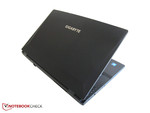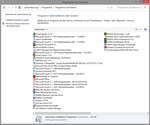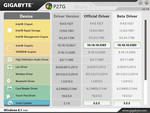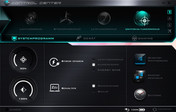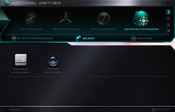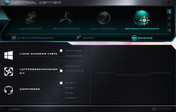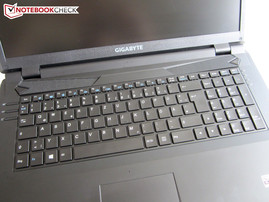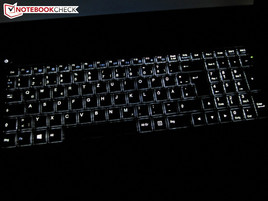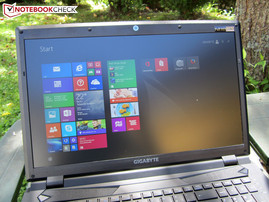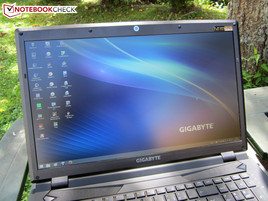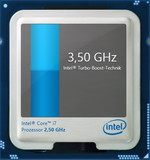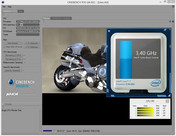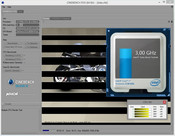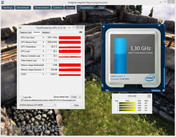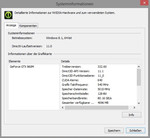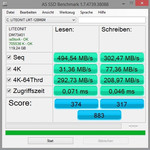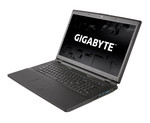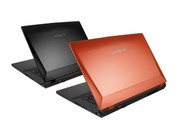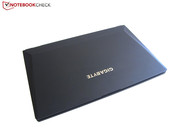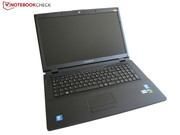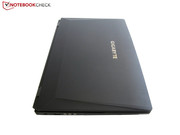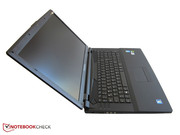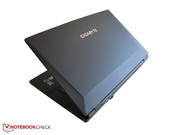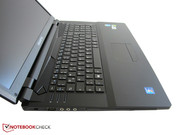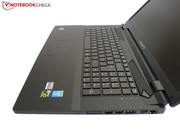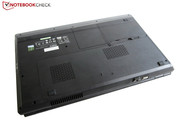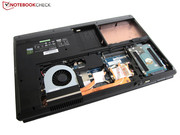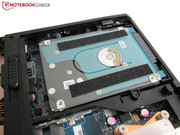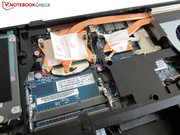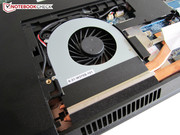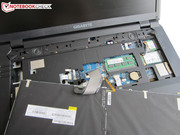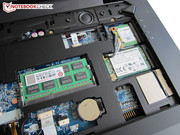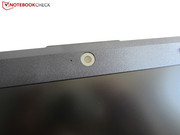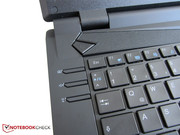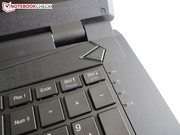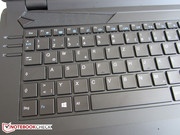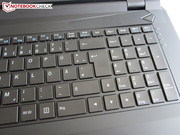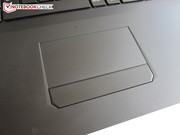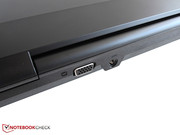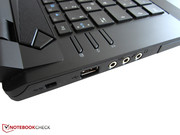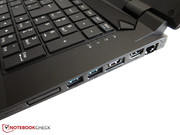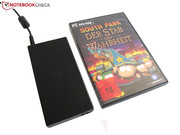Gigabyte P27G v2 Notebook Review
For the original German review, see here.
While Asus sells its G750JM-T4014H for 1,400 Euros (~$1876), the similarly efficient Gigabyte P27Gv2 can be purchased for 1,200 Euros (~$1608). Unlike the Asus model, our test device does not only offer an HDD, but also a 128 GB SSD.
In addition, the other features are impressive. Among other things, Gigabyte implements a Blu-ray drive and a 2.5-3.5 GHz quad-core processor from Intel's Haswell generation. The 8 GB DDR3-RAM works in single-channel mode (3 internal memory banks for a maximum of 24 GB). The anti-glare panel has a resolution of 1920x1080 pixels, thus the standard of a current 17-inch notebook.
Case
The trained eye will recognize the chassis of the P27G v2. No surprise, considering that Gigabyte uses the W370SS Chassis of the gaming expert Clevo. The manufacturer adjusts the notebook so much that it barely resembles the Barebones version Nexoc G728II.
Instead of a silver-gray plastic surface, a black rubber coating is used (lid & around the keyboard), which feels of higher quality in direct comparison. The touchpad and the bar that houses the speakers also differ from the Nexoc G728II.
Due to the cover design, the P27Gv 2 is slightly higher (49 vs. 44 millimeters; 1.93 vs. 1.73 inches). Other gaming notebooks from 2014 (for example the MSI GS70 or the Aorus X7 v2) are considerably thinner, but are louder and heat up more, not to mention the worse upgrade possibilities (screwed battery, soldered CPU...). Despite the thick design, the 17-inch notebook is not inconveniently heavy. Even so, its weight of 3.1 kg (~6.8 pounds) is more suited for stationary use. Also concerning the amount of ports and display quality, the P27G v2 is well suited as a desktop replacement.
Speaking of quality: due to the lack of metal surfaces, the casing "only" leaves a decent impression. With the exception of the Blu-ray combo, the test device has a solid build. Stability will also satisfy most demands. Only the lid and the area around the drive show notebook-like flaws.
Connectivity
Interfaces
With its amount of interfaces, the P27Gv 2 can keep up with its competitors. Three audio jacks (input, output & S/PDIF) are above average, just like three USB-3.0 ports and a card reader, which can handle nine formats. On top of that, it has an eSATA-port. Otherwise, standard interfaces are implemented, may it be Kensington Lock or RJ45-LAN. External displays can be connected via VGA or digitally via HDMI.
We especially liked the way the interfaces are distributed. Admittedly, there could be less ports on the right side (keyword is the use of a mouse), but due to the back-heavy distribution, cables are seldom annoying. Other notebooks restrict the user significantly.
Wireless Communication
Despite the missing ac-support, the wireless adaptor does not show any flaws. The range of the Realtek RTL8723BE is approximately on the same level as mid-priced Intel products (Wireless-N 7260 etc.). 10-15 meters (~33-49 feet) router distance or several walls? These are mostly no problem for the Gigabyte P27G v2. Next to Wi-Fi 802.11 b/g/n, the adaptor also supports Bluetooth 4.0.
Maintenance
Additional points are granted for the comfortable maintenance. When unscrewing the two bottom lids, cooling system (fan + heat pipes), processor and graphics card can be accessed, where the GeForce GTX 860M cannot be exchanged. Due to the 2.5-inch duct and the empty internal memory banks, the device can be upgraded after buying. In order to reach the wireless module, the mSATA duct and the 8 GB DDR3-RAM, more steps are required as can be seen in our pictures. Non-professionals should not be scared by removing the keyboard.
Software
As may be recognized from Gigabyte, the extent of software is neither exaggerated nor poor. Next to practical tools (especially Smart Update), the buyer discovers a media player (CyberLink PowerDVD 10), a pdf-reader and a trial version of Microsoft Office 365.
The Control Center is divided into system program, device and gaming (compare screen shots). Since Gigabyte does not use recovery media, the operating system should be saved using the tool Smart USB Backup. System recovery is also possible via the Windows 8 function.
Accessories
Accessories are limited to a warranty card, a driver and tool DVD as well as a manual. In order to ease the incorporation of a secondary HDD or SSD, several screws and a plastic cover are included. The notebook is powered by a 120-Watt power adaptor, which is 25 millimeters (~0.6 inches) flat and weighs 460 grams (~16.2 oz). The 8-cell battery weighs 426 grams (~15.0 oz).
Input Devices
Keyboard
Even thought the keyboards of the P27G v2 and the Nexoc G728II are visually similar, the P27G v2 has a better input. Gigabyte includes an illumination in its version, making nightly writing, browsing and gaming more comfortable. Admittedly, the manufacturer restricts itself to one brightness setting only.
Independent of that, the keyboard can be rated as good. Next to the layout, mechanics are well thought through. Pressure point, stability and keystroke are positive, only typing noise could be more silent and less clattering.
The choice of a Chiclet keyboard depends on taste. Not every user likes free-standing keys. The presence of a number pad is anyway a positive aspect. If one does not like the Fn-keys, one can switch on (/off) webcam, speakers and wireless adaptor directly via three special keys on the left edge.
Touchpad
We cannot understand why not only the wrist rest, but also the touchpad is rubberized. Despite the relatively smooth surface, the fingers are sometimes significantly slowed down. A size of 91 x 46 millimeters (~3.6 x 1.8 inches) is also not very large for a 17-inch notebook. For comparison: dimensions of the Asus G750 are 117 x 66 millimeters (~4.6 x 2.6 inches).
The multi-touch support does not satisfy us either. Zooming and scrolling often feel chopped. The same holds for dedicated scrolling at the edge of the touchpad. The decision to combine both mouse keys into one bar can also be questioned.
Since the touchpad is not parallel to the spacebar, but slightly shifted to the right, no missed entries are expected while playing games (optional deactivation). Considering everything, one can say that the mouse replacement is only third class. If possible, one should use an external mouse.
Display
It will still take some time before (W)QHD+-displays are established on the market. Accordingly, most manufacturers still rely on conventional FHD panels with 1920x1080 pixels. This resolution is better suited for Windows and games. For 3200x1800 (Schenker XMG P304) or 2880x1620 pixels (MSI GT60), even high-end GPUs have to become more powerful - at least for games such as Crysis 3 or Battlefield 4.
| |||||||||||||||||||||||||
Brightness Distribution: 79 %
Center on Battery: 336 cd/m²
Contrast: 1344:1 (Black: 0.25 cd/m²)
ΔE ColorChecker Calman: 11.38 | ∀{0.5-29.43 Ø4.79}
ΔE Greyscale Calman: 11.88 | ∀{0.09-98 Ø5}
55% AdobeRGB 1998 (Argyll 1.6.3 3D)
62.2% AdobeRGB 1998 (Argyll 3D)
86.1% sRGB (Argyll 3D)
61% Display P3 (Argyll 3D)
Gamma: 2.73
CCT: 16095 K
The integrated Chi Mei N173HGE is one of the most successful models ever. People not using the notebook for professional image and video processing will be satisfied with the image quality. Even though the color space is not excellent (75% sRGB, 55% AdobeRGB) and illumination is rather modest with 79%, the image is subjectively bold and leaves - apart from a blue cast - a rather natural impression. The weak points of the grayscales, the RGB-balance and the color precision/ saturation (CalMAN-Screenshots) are acceptable for gamers.
Due to the high contrast, games and movies are clearly represented. More than 1,000:1 is only achieved by a few notebooks. Note: since we are now measuring the black level with different software, results deviate sometimes significantly from the Nexoc G728II, which has the same panel. Brightness is 303 cd/m², almost identical. Also thumbs up for the outdoor suitability. Matte displays reflect less when exposed to (in)direct sunlight as compared to glossy ones.
Viewing angles are relatively large for a TN panel. As long as it is not too tilted when sitting vertically in front of the display, there are no annoying image changes. Competing against an IPS panel is still difficult for the Chi Mei N173HGE. 17-inch notebooks with IPS technology are scarce (HP ZBook 17).
Performance
Processor
As expected, the P27G v2 is equipped with an Intel quad-core CPU. The Core i7-4710MQ is actually a Core i7-4700MQ, which is sped up by 100 MHz. The 6 MB L3-Cache indicates a high-end product, just like 1.4 billion transistors.
Another characteristic is the Hyperthreading technology. By simulating four virtual cores, up to eight parallel threads are possible. The automatic overclocking function turbo boost is another feature.
We see some disadvantages in terms of power consumption and waste heat. 47-Watts TDP need to be cooled down accordingly. Intel's Haswell generation, which uses a 22 nm process, tends to develop high temperatures (which concerns especially the four-core processors). It comes as no surprise that the P27G v2 supports Nvidia's Optimus technology. Depending on the application, either the GeForce GTX 860M or the HD Graphics 4600 is used.
Turbo Boost
Too bad: turbo mode of the Core i7-4710MQ is only partly used. While 3.3-3.5 GHz for a single-core load is more than respectable (some drops to 3.0-3.1 GHz), CPU levels off at around 3.0 GHz for multi-core use, where the clock pulse falls temporarily to 2.6 GHz. Indeed, we could not observe any throttling in the stress test; the limited turbo, however, can be noted in the benchmarks now and then. And with that, we do not only refer to CPU tests, but also to 3D applications (for example games that require several processors, like GRID: Autosport).
CPU Performance
Despite smaller overclocking flaws, the P27G v2 is a high-class device. 599 points in the multi-CPU test of the Cinebench R15 is definitely not achieved by a dual-core. Other gaming notebooks are much faster due to full turbo, may it be the Asus G750JM-T4014H with a Core i7-4700HQ (642 points) or the test configuration of the Alienware 17 with a Core i7-4700MQ (643 points). A lag of 7% is, however, barely significant for practical use. In comparison with the Core i7-4800MQ (680 points @ MSI GT70 2PE-890US) and Core i7-4810MQ (680 points @ Schenker XMG P724), lag already amounts to 12%. A similar ranking is the result of the single-CPU test.
| Cinebench R15 | |
| CPU Single 64Bit (sort by value) | |
| Gigabyte P27G v2 | |
| Asus G750JM-T4014H | |
| Alienware 17 | |
| MSI GT70 2PE-890US | |
| Schenker XMG P724 | |
| CPU Multi 64Bit (sort by value) | |
| Gigabyte P27G v2 | |
| Asus G750JM-T4014H | |
| Alienware 17 | |
| MSI GT70 2PE-890US | |
| Schenker XMG P724 | |
| Cinebench R11.5 | |
| CPU Single 64Bit (sort by value) | |
| Gigabyte P27G v2 | |
| Asus G750JM-T4014H | |
| Alienware 17 | |
| MSI GT70 2PE-890US | |
| Schenker XMG P724 | |
| CPU Multi 64Bit (sort by value) | |
| Gigabyte P27G v2 | |
| Asus G750JM-T4014H | |
| Alienware 17 | |
| MSI GT70 2PE-890US | |
| Schenker XMG P724 | |
Graphics Card
Unlike the Clevo P150SM-A Barebones, the Gigabyte P27G v2 uses the Maxwell and not the Kepler version of the GeForce GTX 860M. Even though the Kepler has 80% more shaders (1,152 vs. 640), the Maxwell processes up to 10% faster.
On the one hand, this fact is due to the higher core clock speed: 1,029-1,097 MHz vs. 797-915 MHz for the Kepler version. On the other hand, the fresh CPU architecture shows a much better efficiency.
It is a bit annoying that the GTX 860M has to make do with a 128-bit memory interface. Some genres (huge, cohesive fantasy worlds) ask for 191 or 256-bit. At least Nvidia uses a modern storage type. Two GB GDDR5-VRAM are more than sufficient for most games. Only a few new games cannot be played with maximum optics (Watch Dogs, Wolfenstein: The New Order).
GPU Performance
The results of the synthetic graphics benchmark are almost 1:1 with the Nexoc G728II. 3,928 points in the Fire-Strike-Test of the 3DMark 13 are proof of a very powerful notebook. With this value, the Gigabyte P27G v2 ranks between the MSI GE70-2PCi785 (3,596 points @ GTX 850M GDDR5) and the Asus G750JM-T4014H (4,199 points @ GTX 860M), whose graphics card is additionally overclocked. Nvidia's second best model from the 800's-series, the GeForce GTX 870M, is around 20% better (4,664 points @ One K73-4N). First place is currently awarded to the GeForce GTX 880M. 6,095 points (Schenker XMG P704) correspond to an additional 55%.
Similar behavior is shown in the Unigine Heaven 3.0 benchmark. Using a resolution of 1920x1080 pixels, high level of details and ordinary tessellation, the frame rate amounts to 49 fps. The frame rate of the GDDR5-version of the GeForce GTX 850M is only 46 fps. Nowadays, a GeForce GTX 870M achieves a 30% better result (~65 fps). Nvidia's high-class graphics card has a 60% better frame rate (~81 fps).
| Unigine Heaven 3.0 - 1920x1080 DX 11, Normal Tessellation, High Shaders AA:Off AF:Off (sort by value) | |
| Gigabyte P27G v2 | |
| MSI GE70-2PCi785 | |
| Nexoc G728II | |
| Asus G750JM-T4014H | |
| One K73-4N | |
| Schenker XMG P704 | |
| 3DMark - 1920x1080 Fire Strike Graphics (sort by value) | |
| Gigabyte P27G v2 | |
| MSI GE70-2PCi785 | |
| Nexoc G728II | |
| Asus G750JM-T4014H | |
| One K73-4N | |
| Schenker XMG P704 | |
| 3DMark 11 - 1280x720 Performance GPU (sort by value) | |
| Gigabyte P27G v2 | |
| MSI GE70-2PCi785 | |
| Nexoc G728II | |
| Asus G750JM-T4014H | |
| One K73-4N | |
| Schenker XMG P704 | |
| 3DMark Vantage - 1280x1024 P GPU no PhysX (sort by value) | |
| Gigabyte P27G v2 | |
| MSI GE70-2PCi785 | |
| Nexoc G728II | |
| Asus G750JM-T4014H | |
| One K73-4N | |
| Schenker XMG P704 | |
| 3DMark Vantage P Result | 19148 points | |
| 3DMark 11 Performance | 5153 points | |
| 3DMark Ice Storm Standard Score | 96645 points | |
| 3DMark Cloud Gate Standard Score | 15405 points | |
| 3DMark Fire Strike Score | 3663 points | |
Help | ||
Storage Devices
As already mentioned, the 17-inch notebook has a combination of HDD and SSD. By analogy with the P34G v2 and the P35W v2, Gigabyte puts the operating system on the Liteonit LMT-128M6M mSATA solid-state drive.
Its performance values are appropriate for the notebook price. 302 MB/sec for sequential writing and 495 MB/sec for sequential reading (AS SSD benchmark) could also originate from a 2.5-inch notebook. Seek time (0.071 ms @ read, 0.046 ms @ write) and performance in the 4k range also turns out to be ordinary.
Since not even 100 GB is available in practice (Windows 8.1, drivers, tools...), Gigabyte integrates a second mass storage. The MQ01ABD100 from Toshiba is a familiar HDD, which is used in many notebooks. The 1,000 GB drive performs the CrystalDiskMark sequential test with 118-119 MB/sec. Not even some 7,200-rpm HDDs can keep up with that.
System Performance
The overall score of the PCMark7 benchmark gives a rough impression of the system performance. 5,365 points, which the P27G v2 achieved, are respectable. Next to the Asus G750JS-T4064H (Core i7-4700HQ, GeForce GTX 870M), the Gigabyte P34G v2 (Core i7-4700HQ, GeForce GTX 860M) achieves a similar result.
| PCMark 7 Score | 5365 points | |
| PCMark 8 Home Score Accelerated v2 | 3393 points | |
| PCMark 8 Creative Score Accelerated v2 | 4019 points | |
| PCMark 8 Work Score Accelerated v2 | 4286 points | |
Help | ||
Gaming Performance
Even though the notebook is equipped with an outdated GPU driver (ForceWare 332.60), the GeForce GTX 860M performs well in the gaming test. As long as the user does not exaggerate with the quality settings and anti-aliasing, most games can be played smoothly. High level of details and twofold MSAA seldom brings the device to its limit (Watch Dogs & Crysis 3). If all menu items should run smoothly, at least a GeForce GTX 870M is required. We advise extremely passionate gamers to buy a GTX-880M-equipped device.
| Call of Duty: Ghosts - 1920x1080 Extra / High / HBAO+ / No dynamic fur AA:4x MS (sort by value) | |
| Gigabyte P27G v2 | |
| MSI GE70-2PCi785 | |
| Nexoc G728II | |
| Asus G750JM-T4014H | |
| One K73-4N | |
| Schenker XMG P704 | |
| low | med. | high | ultra | |
|---|---|---|---|---|
| Crysis 3 (2013) | 110.8 | 76.4 | 50.4 | 18.8 |
| Dota 2 (2013) | 111.3 | 93.4 | 72 | |
| Battlefield 4 (2013) | 108.7 | 93.5 | 70.2 | 28.4 |
| Call of Duty: Ghosts (2013) | 76.2 | 74.1 | 49.1 | 30.7 |
| Wolfenstein: The New Order (2014) | 60 | 60 | 46.9 | |
| Watch Dogs (2014) | 54.4 | 46.8 | 26.6 | |
| GRID: Autosport (2014) | 118.8 | 68 | 52.7 | 39.7 |
Emissions
System Noise
The P27G v2 is neither the noisiest nor the quietest gaming notebook. 41-44 dB(A) in 3DMark 06 represent a clearly audible level, which is, however, still acceptable. That it is theoretically possible to obtain better noise emissions is proven by the Asus G750JM-T4014H. The 17-inch competitor performs 3DMark 06 with just 38 dB(A). The Nexoc G728II and the MSI GE70-2PCi785 were noisier (46-47 dB(A)). Another image is conveyed in the stress test. With 51 dB(A), the P27G v2 exceeds the previously mentioned notebooks (47-48 dB(A)). The reason for the higher values is easily identified. Unlike for its competitors, the CPU of the P27G v2 does not throttle under full load. Only the graphics chip operates slightly below its standard level (993 vs. 1,029 MHz).
If the notebook is hardly stressed or not stressed at all, the fan remains quiet. 30-33 dB(A) in idle mode is relatively low (34-36 dB(A) @ MSI GE70). The HDD cannot be criticized as well: it whooshes at a moderate 31 dB(A) and it clatters temporarily. The Blu-ray drive is medium with 36 dB(A), which is also acceptable.
Noise level
| Idle |
| 30.2 / 30.6 / 32.6 dB(A) |
| HDD |
| 30.8 dB(A) |
| DVD |
| 36.4 / dB(A) |
| Load |
| 44 / 50.8 dB(A) |
 | ||
30 dB silent 40 dB(A) audible 50 dB(A) loud |
||
min: | ||
Temperature
Due to the massive construction, the chassis remains significantly cooler than slimmer notebooks. While the MSI GS70 heats up to 63 °C (145.4 °F) in extreme cases, the P27G v2 "only" reaches 49 °C (120.2 °F). The average value is 38 °C (100.4 °F) on the top and 33°C (91.4 °F) on the bottom, also lower (P27G v2, 48 and 55 °C @ GS70; 119.4 and 131 °F). If the device is not tortured, values for the MSI are better. A surface temperature of 28 °C (82.4 °F) indicates a pleasant MS Office and web operation.
Points of improvement are at most the chassis interior. After one hour of stress test with the FurMark and Prime95 tools, the Core i7-4710MQ climbs to over 90 °C (194 °F; according to the CPUID HWMonitor). For the GeForce GTX 860M a value of 83 °C (181.4 °F) was measured. In gaming mode, temperature progression is lower.
(-) The maximum temperature on the upper side is 49.3 °C / 121 F, compared to the average of 40.5 °C / 105 F, ranging from 21.2 to 68.8 °C for the class Gaming.
(±) The bottom heats up to a maximum of 42.4 °C / 108 F, compared to the average of 43.3 °C / 110 F
(+) In idle usage, the average temperature for the upper side is 30.4 °C / 87 F, compared to the device average of 33.9 °C / 93 F.
(+) The palmrests and touchpad are cooler than skin temperature with a maximum of 27.3 °C / 81.1 F and are therefore cool to the touch.
(±) The average temperature of the palmrest area of similar devices was 28.9 °C / 84 F (+1.6 °C / 2.9 F).
Speakers
The integrated 2.0 system should be considered a stopgap. Despite the Sound Blaster Cinema technology, which offers three scenarios and five sound optimizations, audio files seem quite brassy. Next to precision, the device also lacks bass. Without a subwoofer, a powerful base is difficult to realize. Not even the maximum volume can make up for this flaw. To cut to the chase: you should trust a headset or external speakers. MSI is definitely better in terms of sound (GT70).
Energy Management
Power Consumption
Energy demand is mediocre. 15-29 Watts in idle mode and 88-106 Watts for the first part of 3DMark 06 are almost identical with the Nexoc G728II. The main competitor, Asus' G750JM, is to a great extent, more economical. Only under full load, the measuring device indicated a higher value (147 vs. 133 Watts). One reason could be the overclocking of the GeForce GTX 860M.
| Off / Standby | |
| Idle | |
| Load |
|
Key:
min: | |
Battery Life
In terms of battery life, the P27G v2 performs well. Two to maximum five hours are sufficient for a gaming notebook and corresponds with the performance of the Nexoc G728II. Mobility junkies should resort to the Asus G750JM. Due to the more powerful battery (89 vs. 77 Wh) and the lower consumption in idle mode, the battery of the 17-inch notebook lasts almost 8 hours. Thumbs up for the clock speed of the GeForce GTX 860M which remains constant when running on battery only. Not so positive is the fact that the Core i7-4710MQ is throttled to 1.5 GHz.
Verdict
With its P27G v2, Gigabyte offers a high-end notebook, which addresses "couch potatoes" rather than gamers that like to travel. 3.1 kg (~6.8 pounds) and around five centimeters (~2 inches) height are suboptimal for frequent transports.
If one desires a slimmer design, other 17-inch gaming notebooks such as the MSI GS70 or the Aorus x7 v2 should be considered. The fact that Gigabyte chose a rubberized touchpad will also not convince every user. The moderate sound quality and the limited CPU turbo also lower the overall score.
All in all, the positive aspects outweigh the negative, especially the large equipment. Gigabyte not only implements a Blu-ray drive and an mSATA-SSD, but also sufficient ports and upgrade possibilities (RAM banks, 2.5-inch ducts...). Gaming power is also not bad. Nvidia's GeForce GTX 860M handles almost all games in great details. Together with the keyboard illumination, which is not part of the Clevo original (Nexoc G728II), the P27G v2 results in a fancy high-end notebook.





